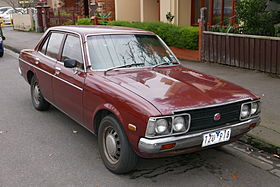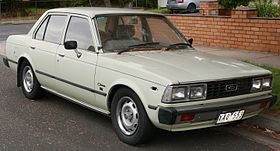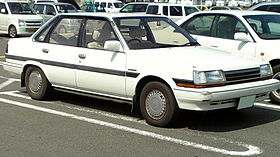Toyota Corona
| Toyota Corona | |
|---|---|
 |
|
| Overview | |
| Manufacturer | Toyota |
| Production | 1957–2003 |
| Body and chassis | |
| Class |
Compact car (1957–1992) Mid-size car (1992–2003) |
| Chronology | |
| Predecessor | Toyopet Master |
| Successor |
|
| First generation (T10) | |
|---|---|
 |
|
| Overview | |
| Also called | Toyopet Corona |
| Production | 1957–1960 |
| Assembly | Japan: Toyota, Aichi (Honsha plant) |
| Body and chassis | |
| Body style |
|
| Layout | Front-engine, rear-wheel-drive |
| Related | |
| Powertrain | |
| Engine | |
| Transmission | 3-speed manual transmission |
| Dimensions | |
| Wheelbase | 2,400 mm (94.5 in) |
| Length | 3,912 mm (154 in) |
| Width | 1,471 mm (57.9 in) |
| Height | 1,519 mm (59.8 in) |
| Curb weight | 960 kg (2,120 lb) |
| Second generation (T20/T30) | |
|---|---|
 |
|
| Overview | |
| Also called | Toyopet Corona Toyota 1900 Toyota Tiara |
| Production | March 1960 – September 1964 April 1963 – unknown (Australia) |
| Assembly |
|
| Body and chassis | |
| Body style |
|
| Layout | Front-engine, rear-wheel-drive |
| Powertrain | |
| Engine | |
| Transmission |
|
| Dimensions | |
| Wheelbase | 2,400 mm (94 in) |
| Length | 3,990 mm (157 in) |
| Width | 1,490 mm (59 in) |
| Height | 1,440 mm (57 in) |
| Curb weight | Sedan: 940–980 kg (2,070–2,160 lb) |
| Third generation (T40/T50) | |
|---|---|
 |
|
| Overview | |
| Also called | Toyopet Corona |
| Production |
|
| Assembly |
|
| Body and chassis | |
| Body style |
|
| Layout | Front-engine, rear-wheel-drive |
| Powertrain | |
| Engine | |
| Transmission |
|
| Dimensions | |
| Wheelbase | 2,420 mm (95.3 in) |
| Length | 4,110 mm (161.8 in) |
| Width | 1,550 mm (61.0 in) |
| Height |
|
| Curb weight |
|
| Fourth generation (T80/T90) | |
|---|---|

Toyota Corona (RT81) SE sedan
|
|
| Overview | |
| Production | Feb 1970 – July 1973 |
| Assembly |
|
| Body and chassis | |
| Body style |
|
| Layout | Front-engine, rear-wheel-drive |
| Powertrain | |
| Engine | |
| Transmission |
|
| Dimensions | |
| Wheelbase | 2,430 mm (95.7 in) |
| Length |
|
| Width | 1,570 mm (61.8 in) |
| Height |
|
| Curb weight |
|
| Fifth generation (T100/T110/T120) | |
|---|---|
 |
|
| Overview | |
| Also called | Toyota 2000 (UK market) |
| Production | Aug 1973—May 1979 |
| Assembly |
|
| Body and chassis | |
| Body style |
|
| Layout | Front-engine, rear-wheel-drive |
| Powertrain | |
| Engine | |
| Transmission | |
| Dimensions | |
| Wheelbase | 2,500 mm (98.4 in) |
| Length |
|
| Width |
|
| Height |
|
| Curb weight |
|
| Sixth generation (T130) | |
|---|---|
 |
|
| Overview | |
| Production | Sep 1978 – Apr 1983 September 1979–1983 (Australia) |
| Assembly |
|
| Body and chassis | |
| Body style | 4-door sedan 2-door hardtop coupe 5-door liftback 5-door station wagon |
| Layout | Front-engine, rear-wheel-drive |
| Powertrain | |
| Engine | |
| Transmission | |
| Dimensions | |
| Wheelbase | 2,525 mm (99.4 in) |
| Length |
|
| Width | 1,655 mm (65.2 in) |
| Height |
|
| Curb weight |
|
| Seventh generation (T140) | |
|---|---|

Pre-facelift Toyota Corona CS-X sedan (ST141, Australia)
|
|
| Overview | |
| Production | Jan 1982—Dec 1987 1983 – February 1987 (Australia) |
| Assembly |
|
| Body and chassis | |
| Body style | |
| Layout | Front-engine, rear-wheel-drive |
| Related |
Toyota Celica Toyota Carina |
| Powertrain | |
| Engine |
|
| Transmission | |
| Dimensions | |
| Wheelbase | 2,500 mm (98.4 in) |
| Length | 4,570 mm (179.9 in) |
| Width | 1,660 mm (65.4 in) |
| Height | 1,415 mm (55.7 in) |
| Curb weight | 1,165 kg (2,568 lb) |
| Seventh generation (T150) | |
|---|---|
 |
|
| Overview | |
| Also called | Toyota Carina II (Europe) |
| Production | Jan 1983 – Dec 1987 |
| Assembly |
|
| Body and chassis | |
| Body style | |
| Layout | Front-engine, front-wheel-drive |
| Related | |
| Powertrain | |
| Engine | |
| Dimensions | |
| Wheelbase |
|
| Length | 4,360–4,390 mm (171.7–172.8 in) |
| Width | 1,670 mm (65.7 in) |
| Height | 1,365 mm (53.7 in) |
| Curb weight | 1,005 kg (2,215.6 lb) |
| Eighth generation (T170) | |
|---|---|
 |
|
| Overview | |
| Also called | Toyota Carina II (Europe) |
| Production | Dec 1987 – May 1992 |
| Assembly |
|
| Body and chassis | |
| Body style |
|
| Layout | Front-engine, front-wheel-drive |
| Related | Toyota Carina |
| Powertrain | |
| Engine | |
| Dimensions | |
| Wheelbase | 2,525 mm (99.4 in) |
| Length | 4,440 mm (174.8 in) |
| Width | 1,690 mm (66.5 in) |
| Height | 1,370 mm (53.9 in) |
| Curb weight | 1,130 kg (2,491.2 lb) |
The Toyota Corona (Japanese: トヨタ・コロナ) is an automobile manufactured by the Japanese automaker Toyota between 1957 and 2003. Traditionally, the competitor from Nissan was the Nissan Bluebird. The word "" is Latin for "crown", a reference to an earlier vehicle Toyota offered called the Toyota Crown. It was exclusive to Toyopet Store dealership channels in Japan, while the larger Crown was available only at Toyota Store locations.
In many countries, the Corona was one of Toyota's first international exports, and was shortly joined by the smaller Toyota Corolla, providing buyers with a choice of a larger car, with similar operating expenses to the smaller Corolla. The Corona was Toyota's second sedan in their hierarchy of products, just below the Crown, until 1968 when the Corona name was used on a larger, all new platform called the Toyota Corona Mark II, which gave buyers more interior space while still offering dependable, affordable performance.
The Corona became successful in export markets and was marketed under a number of different nameplates worldwide—including those branded in much of Asia as Coronas marketed in European markets as Carinas.
The first-generation Corona, introduced in May 1957, was designed with parts from the previous-generation Crown and Master following a major restyle and enlargement of the Crown. Many of the body panels were cut down from the Master which had ceased production. Aside from the four-door sedan, the ST16/PT16 van versions were also available. Originally, the ST10/16 Corona was fitted with the old sidevalve "S" engine, with 33 PS (24 kW). In April 1958 the Corona underwent a light facelift, with a new hood ornament and door handles. The tail light design of this generation is reminiscent of the 1949 Ford sedan.
The 997 cc (60.8 cu in) OHV P series engine replaced the old S in September 1959, and offered substantially more power with 45 PS (33 kW) at 5,000 rpm. The P-engined Corona sedan was capable of traveling at 105 km/h (65 mph). The car also underwent another facelift, including a mesh grille and a new rear seat which allowed seating for five rather than the previous four. As regulations regarding taxis at the time required engines no larger than 910 cc (56 cu in), dealers restricted the power for taxi vehicles. Due to the upgrade in dimensions of the Crown, Toyota needed to continue manufacturing a vehicle with similar size dimensions to the first Crown, primarily to be used for taxi usage. This vehicle saw the introduction of a monocoque chassis structure, and an independent front suspension using double wishbones. Due to the monocoque chassis, Toyota was able to produce a vehicle under 1,000 kg (2,200 lb).
...
Wikipedia
